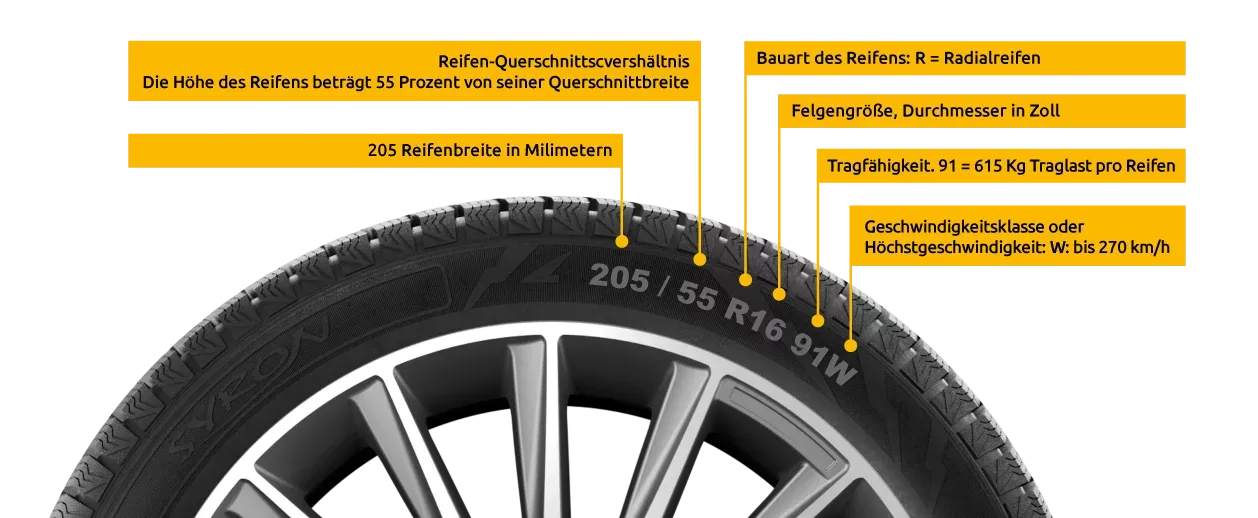Where can I find the tire size?
The easiest way is to look at the sidewall of the old tire to see what size tire you have previously used. There you will find all the important key figures such as tire size, load capacity or maximum speed and other information.

You will also find the relevant information on the registration certificate part 1 (this used to be the vehicle registration document). Here you can determine whether other tires may be suitable. Your tire dealer can also advise you if, for example, you want to convert wide tires.
What does the carrying capacity index mean?
This value, also given as the load index, load index or LI value, indicates the maximum load that a tire can carry. You must not exceed this value under any circumstances. This could damage the tire. Example: 91 means a maximum load of up to 615 kg.

What is the maximum speed I can drive?
The so-called speed index reveals how fast you are allowed to travel. This can be read in a speed index table. An example: behind the size designation and the load index on the sidewall of the tire you will find the speed index V according to the table means a maximum speed of up to 240 km/h.
The most common speed categories are::
Q = 160 km/h
R = 170 km/h
S = 180 km/h
T = 190 km/h
H = 210 km/h
V = 240 km/h
W = 270 km/h
Y = 300 km/h
How can I determine the age of the tires?
This information can also be read on the side wall. With the designation DOT (Department of Transportation), the last 4 digits indicate both the week of production and the year of production. For safety reasons, a tire should not be in use for longer than approx. 10 years. Incorrect storage can cause damage beforehand. Please have it checked regularly after 5-6 years.

The tire number shown means: Manufactured in week 48, 2018..
When should I buy new tires?
If you are threatened with 1 point in Flensburg and a €60 fine. Because if your tire has less than 1.6 millimeters of remaining tread, then you should act as soon as possible. New tires have a tread depth of seven to nine millimeters. You can do a rough residual profile test with the 1 euro coin. If the gold edge disappears, there is still a profile of approx. 3 mm. After a series of tests, the ADAC determined that the legally stipulated tread depth of 1.6 mm only offers a low level of safety. At least 3 mm for summer tires and 4 mm for winter tires would be ideal. You should take this into account when considering your tire purchase. Better safe than sorry.

Which tire is right for me?
Of course, it depends on your vehicle which tires are approved for your vehicle. But beyond that, there are other criteria that you should consider. Think about which qualities are particularly important to you. Whether you want to drive summer and winter tires or get through all seasons with all-season tires.
- Would you like a sporty, high-performance tire that not only proves its worth in everyday use thanks to its excellent driving characteristics, but also has a lot of reserves?
- Or are you using a vehicle that can only reach its full potential with ultra-high-performance tires?
- If you prefer high speed and also want to compete on racetracks, then only a street-legal semi-slick tire will do. Different requirements can also be met with all-weather and winter tires. Do you focus on top performance or rather on ecological aspects?
- As an SUV/4×4 driver, you can opt for sportiness and comfort today. This makes buying tires easier.
- With vans and vans, the focus is more on comfort and durability. This applies to family vans as well as commercial vans. In the Syron Tires program you will always find the right tire that suits your vehicle, your driving style and your personal preferences.
Wasn this article helpful?
You can contact our customer service


